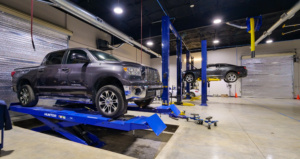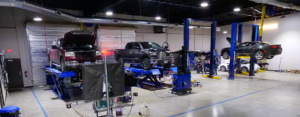 Importance of Proper Tire
Importance of Proper Tire
Balance and Maintenance
Article + Photos by | Gladney Automotive Solutions
Let’s not forget something really important here. Your car can have all manner of cutting-edge wizardry and specialist hardware to make it the perfect ride, but it all means nothing unless you have a set of humble tires sitting underneath it all. A set of properly maintained, regularly rotated tires of a high-order of quality and brand is absolutely essential for your on-road safety and comfort.
Here at Gladney Automotive in College Station, Texas, we’re proud to reveal that we’ve now added tire replacement services as well as tire balancing services to our program. Below you can learn more about what these services involve and why they matter.
Tire Rotation Vs. Tire Replacement – What’s the Difference?
Tire rotation is the process of changing the positions of your current tires in order to ensure that all four of the tires will wear evenly. On most cars, two of the four tires will bear more brunt than the other two. Therefore, a rotation will ensure that you can wear all four tires at about the same pace. When the time comes for replacement, then, you can get a full set of four and remain in sync.
A tire rotation is a relatively simple procedure and should happen about every 7,500 miles or six months, whichever comes first. You can find the exact recommendation for your specific car model in your owner’s manual. Here at Gladney we strongly suggest following that OEM recommendation.
Tire replacement, then, is the process of swapping out old and worn tires for a set of fresh, new ones. Tire rotation is a process for the times when tires are still viable for road use. Tire replacement is a necessary step when tire tread has gone past the minimum legal threshold for road safety, which is 2/32 of an inch.
Don’t misunderstand, we aren’t suggesting that you should wear your tire down to 2/32 of an inch before you get them replaced. That would be an unwise course of action. The tread thickness of 2/32 is simply the absolutely legal limit on safety for tires. In fact, when your tires only have 3/32 or 4/32 of an inch remaining, they are skirting closer and closer to the danger zone, and are therefore not working at their optimum rate.
What is Road Force Balancing for Tires?
Besides tire rotation and replacement, another key service you will need for your tires is road force balancing. This is a solution to the fairly common problem of driver’s experiencing vibrations while they’re driving along. If you sense these vibrations, however, you shouldn’t automatically assume that it’s one of your tires receiving too much road force weight. In fact, the vibrations drivers commonly feel through the steering wheel have many possible causes:
1. Bad wheel alignment
2. Failing driveshaft
3. Engine or transmission fault
4. Broken axle
Another cause, however, is the issue of there being a lack of balance in your tires and one of the wheels getting a disproportionate amount of force than the other three. If this turns out to be the culprit, then your vehicle will need to undergo road force balancing.
What happens is that the mechanic will use a road force balance to measure the force variation in your tire, looking at radial force, lateral force, fore aft force and rotational direction. After finding where there are inconsistencies with the tire, the balancer can then give a clear path of action for the mechanic or technician. They’ll know exactly what to fix because they’ll have a very clear idea where the problem is.
The solution could be adding weights to the tire, or it could be to remount the tire and wheel to ensure a more balanced and proper runout on each tire. It could just be a question of moving the tire on the wheel to find the right high spot and low spot positions. Even with the help of a computer, it’s a fairly tricky process and relies on the mechanic also having a keen sense of what can go wrong with these tires’ balance and how to redress the problem.
How Does Tire Rotation Benefit You?
The first and perhaps the most obvious benefit of proper tire rotation is that you don’t waste tires.
If you were to leave the tires unrotated, then two would invariably wear away before the other two. Not only would that put you in an unsafe position on the road, but it would also create an irritating schedule of tire changing where you would change two at a time. Let’s face it, that’s just unsafe, too.
Proper and timely tire rotation keeps your tire condition in sync and ensures that every time you buy a set of new tires, it’s worth it. Furthermore, it keeps you balanced, safe and on an even keel when you’re driving on the roads.
Reasons to Invest in Great Tires
We can already sense that some readers are asking the question, “aren’t all tire brands basically the same save for the tread pattern and tire season type for winter, summer, and so on?” In fact, this is not the case. Not all tires are created equal, and high-end tires are a good investment for your vehicle. Here’s why:
1. Durability
Companies like Michelin and Continental invest millions into developing more durable and lasting materials with which to make their tires. These formulations are more advanced than the cheaper more generic tires that you can find elsewhere. Your car tires’ durability is one of the thin blue lines of defense that help keep you balanced and safe on the road. Cutting corners on materials and durability shouldn’t be a consideration.
2. Handling
Better tires lead to better handling. By ensuring better traction and grip (see below), you are more able to steer the car around difficult bends and other challenging roads at speed. Cheap tires contribute to poor handling and a constant feeling of being unsteady on the road.
3. Traction
Part of good handling is also good traction, and you get that in spades with high-quality premium tires. Tires that are well-engineered and manufactured can help “glue” you to the road and give you an unbeatable and true sense of security and stability on the road surface. These tires also serve you better in the extreme seasons, in particular during the winter.
4. Braking Distance
The shorter the braking distances your car can achieve, the better. Part of your braking distance equation is directly linked to the quality of your tires. If you want to minimize braking distance, then you have to invest in great-quality tires.
5. Comfort and Noise
Finally, the overall comfort and quality of your ride, especially longer rides, is connected to which tires you use. Cheap tires are noisy, hard and uncomfortable. They may look alright on the surface, but when you hit the freeway and you’re traveling at 75mph or more, they fill your passenger cabin with the worst noise and feel horrendous when riding over any imperfection in the road surface. Invest in quality and you’ll avoid these bad conditions.
How Does Road Force Balancing Benefit You?
First of all, road force balancing is an essential process not just as a responsive measure when things appear to be unbalanced with your existing tires, but as a preventative measure to ensure things won’t get unbalanced with a new set of tires. If you were to purchase a brand-new set of Michelin or Continental tires from us here at Gladney, then you’d want to be sure that they were properly fitted with the perfect balance.
Using our road force balancing equipment and techniques, as well as our considerable industry knowledge, we can ensure that any set of new tires of whatever size does not upset the overall balance of your vehicle. Another benefit of road force balancing, be it responsive or preventative, is that it solves and eliminates the problems of wheel vibrations caused by your rims and tire runout being out of balance. In turn, restoring the proper balance to your wheels is instrumental in improving the car’s handling and drive quality.
Such services are particularly beneficial to drivers of high-end cars like Audi and Mercedes-Benz. It’s common for owners of these brands to seek out high-end tires and to perform wheel upgrades from stock OEM. Ensuring that these new rims and tires are in perfect balance is therefore essential.
